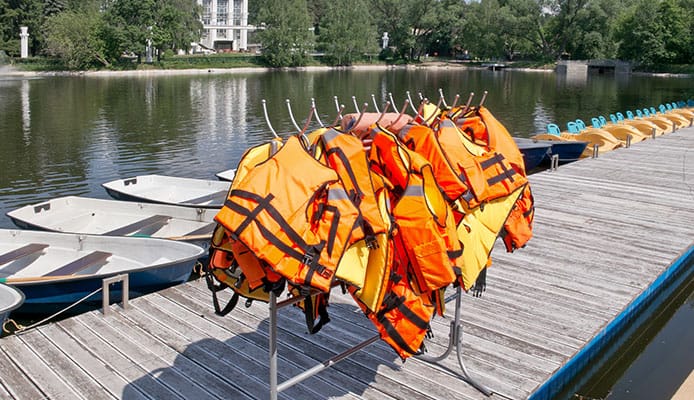
Life jackets are essential for your safety, which is why wearing a life jacket is required by law for all persons engaged in water-based activities like sailing, wakeboarding, and others. However, life jackets are only effective if they are in good working condition, so it is important that you clean and maintains your life jackets regularly. Doing so will help to prolong their service life and performance. Besides, who would want to wear a dirty and stinky life jacket anyway? Below we outline the general steps and procedures on how to clean life jackets, as well as some maintenance tips and advice so you can be sure that you’re wearing clean and fresh life jackets all the time.
Cleaning Your Life Jackets
You must clean your life jackets immediately if they come in contact with mud, food, or sunscreen as these chemicals can damage the fabric of even the best life jackets available. You should also make it a practice to clean your life jackets at least once a month or at the end of the boating season since oil and other chemicals from the wearer’s skin will surely be transferred onto the life jacket.
So how do you go about cleaning your life jackets?
- Pick a sunny day to do the cleaning. This will make it easier for you to dry your life jackets after washing them.
- Gather the following cleaning materials:
- Bucket
- Soft-bristled brush and sponge
- Mild detergent/dishwashing liquid
- Water hose
- Clothesline or rack
- Fill half the bucket with water and add in the mild detergent or dishwashing liquid and stir. If you are using powdered detergent, be sure to stir the mixture well to dissolve the powder completely.
- Unfasten all the straps and hardware or buckles in the life jacket.
- Inspect the life jacket for mold and mildew. If there are any, take the life jacket outside and brush away all visible spores from it.
- Once all visible signs of mold and mildew are removed, rinse the life jacket with clean water from the hose.
- Afterward, soak the life jacket in the bucket, take it out and wipe it clean using the sponge.
- For tough stains, apply a dab of detergent directly on the stain. Use a soft-bristled brush and gently scrub the affected area. Avoid applying too much pressure to avoid damaging the life jacket’s fabric. Brush the nylon straps and buckles as well.
- Hose down or rinse the life jacket with clean water. Be sure to smooth out the fabric and get into any crevices (i.e. seams, inside the buckles and fasteners, etc.) and rinse them thoroughly.
- Hang the life jacket on a clothesline or a rack to air dry. Choose a shady and well-ventilated spot and avoid hanging the life jackets under direct sunlight since this will cause the colors to fade. Also, never attempt to speed up the drying process by using a hairdryer as this will weaken the fabric.
- Once the life jacket is completely dry, apply a UV protectant to give it added protection from the sun.
In addition to the above, here are some more tips about cleaning and washing your life jackets.
- You must avoid using any harsh chemicals when cleaning the life jacket. For instance, you should never use bleach or any industrial cleaning agents directly on the life jacket because this will weaken the fabric and damage the foam inside it.
- Never wash your life jackets in a standard washing machine since the swirling motions can break the foam. Some life jackets can be washed in larger washers; however, be sure to read the manufacturers’ instructions and follow them properly, or else the life jacket will get damaged and any warranty that you may have on it will be invalidated.
- It is possible to clean and restore a mold or mildew infested life jacket. However, most experts would recommend that you consider discarding the infested life jacket and get a new one instead. This is especially when it comes to children and infant life jackets. This is because it is possible that the mold and mildew have moved into the foam and padding inside the life jacket, and no amount of cleaning can guarantee 100% that they are removed completely.
Removing Stinky Odors from Life Jackets
Stinky odors on life jackets can be caused by a variety of things including mold and mildew, dried sweat, and body odors. In any case, nobody likes wearing a stinky life jacket. So if you notice some untoward smells emanating from your life jackets, then it’s high time to clean and deodorize them. Although washing the life jacket is usually enough to get rid of the smell, there are instances where a deodorizing solution is necessary, especially when it comes to life jackets for dogs. You can get this online or from most water sports stores.
- Before deodorizing, be sure to clean the life jacket first by following the steps mentioned above. Once the life jacket is completely dry, proceed to the next step.
- Get a bottle of deodorizing solution. In most cases, it is recommended that you add one ounce of the deodorizing solution to at least five gallons of water. But then, the exact measurements will vary depending on the manufacturer, so be sure to read the label and follow the instructions.
- Soak the life jacket into the deodorizing solution for five minutes. The life jacket must be completely submerged in the solution throughout the whole time.
- Remove the life jacket from the cleaning solution and hang it to air dry. Do not rinse or wipe the life jacket, just let the water drip away from it.
Life Jacket Maintenance Tips

Remember that your life jacket is not just any other piece of clothing; it is something which you will be trusting your life with. And if your life lies in the hands of any particular product, then you’ll want to make sure it is always functioning perfectly. Regular inspection and maintenance routines can provide you with peace of mind knowing that your life jacket will be up to the challenge when the need calls for it.
- Never place heavy items on top of the life jacket since this will put pressure on the flotation material or foam and damage it. Along that line, never use your life jacket as a seat padding while onboard a boat.
- Always check the life jacket for rips, tears, and holes before and after using them. Have the damages mended or repaired if possible. Otherwise, consider replacing the life jacket with a new one.
- Life jackets will last much longer if they are stored in a dry and cool place.
- When life jackets will not be used for an extended period of time, remove them from the boat.
- When storing your life jackets in a small space or bin, don’t fold the life jacket or put it under heavy items as this will damage their flotation systems.
You might also like: Life Jacket Laws By State
Inflatable Life Jacket Cleaning and Maintenance
Inflatable life jackets have more technology to work with compared to inherently buoyant life jackets. For one, they have gas cylinders that inflate automatically once you enter the water. As such, cleaning and maintaining inflatables will require a different approach.
Cleaning Inflatable Life Jackets
To wash an automatically inflating life jacket:
- Remove the CO2 cylinder and the sensor bobbin. This is important because once the sensor bobbin gets wet, it will dissolve and the life jacket will inflate automatically.
- Once the hardware’s been removed, deflate the life jacket completely.
- Wash the deflated life jacket using the standard life jacket cleaning procedures mentioned earlier.
- Once the inflatable life jacket is thoroughly dry, re-arm the life jacket with the CO2 cylinder and the sensor bobbin. Along that line, check that the CO2 cylinder has not yet passed its expiration date and replace it if it did.
Note that some manufacturers may have different recommendations as to how you should go about cleaning your inflatable life jacket. Be sure to check the labels and pamphlets that came with your life jacket for the instructions.
Inflatable Life Jacket Maintenance Tips
Because inflatable life jackets have more hardware and mechanisms than inherently buoyant life jackets, inflatables will require more frequent maintenance. Here are some general guidelines that will help you take better care of your inflatable life jacket.
- Inspect the life jacket for any signs of damage before and after using it. Check the fabric for any signs of rips, holes, and tears. Check the straps, buckles, or zippers as well and make sure that they are working properly.
- Check the status of the inflator every time to ensure that the gas cartridge is filled. Replace the spent gas cylinder with new ones immediately. Otherwise, store the life jacket away first until you can get a replacement cylinder. This is to make sure that you don’t accidentally put on a non-working inflatable life jacket.
- Check the life jacket for air leaks at least every other month. You can do this by manually inflating the life jacket and leaving it inflated overnight. If the life jacket has deflated during that time, then there is a chance that it has a leak somewhere and will need to be serviced or replaced.
Globo Surf Overview
Many life jackets get damaged because of neglect and improper cleaning and maintenance practices. Sure, learning how to clean life jackets and maintaining them may sound like a lot of work, but it is necessary to ensure that they are in good working condition every time you use them. As most experts would say, treat your life jacket as though your life depends on it – because it does.
More Life Jacket Safety Guides:
- Everything You Need To Know About Life Jacket Buoyancy
- What Are The Advantages Of A Type IV PFD?
- U.S. Coast Guard Requirements For Inflatable PFDs
- Guide On How To Choose A Life Jacket
- The Differences Between A Life Jacket And PFD

